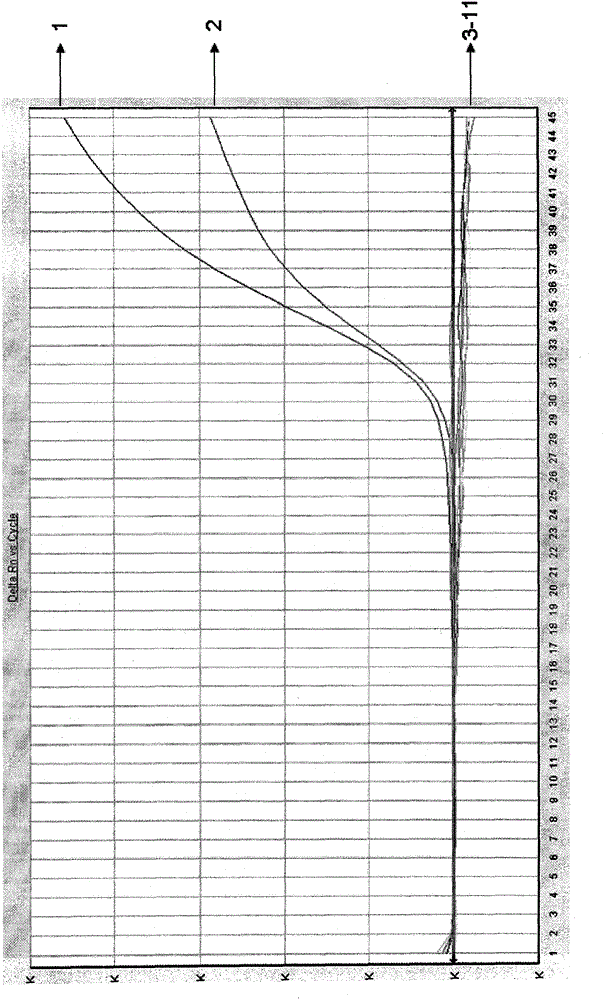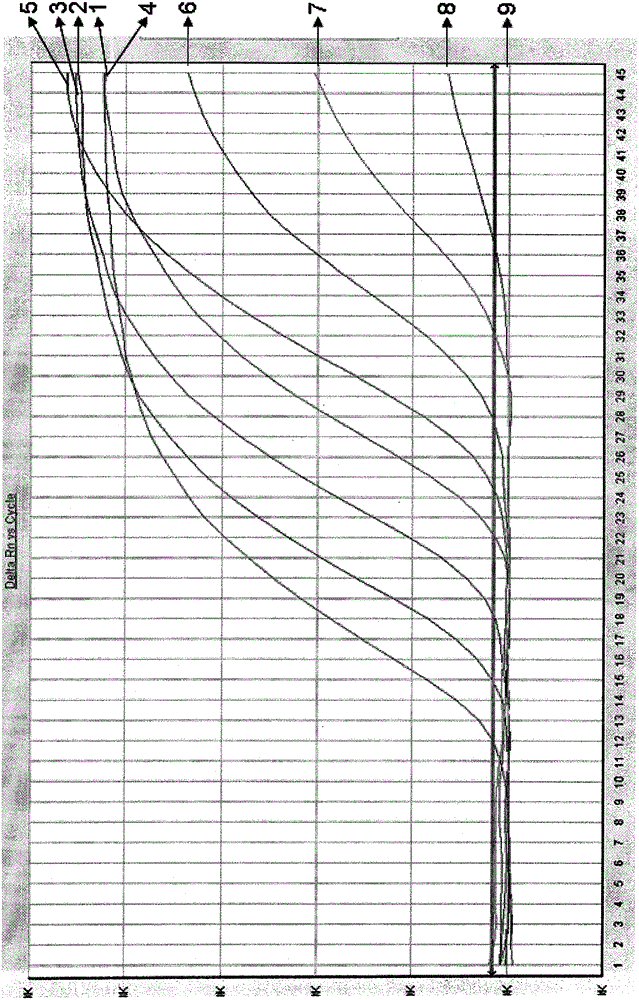Real-time fluorescent PCR (polymerase chain reaction) detection kit for Phomopsis helianthi M.Muntanola-Cvetkovic et al.
A technology of stem canker bacteria and real-time fluorescence, which is applied to the measurement/inspection of microorganisms, DNA/RNA fragments, biochemical equipment and methods, etc. It can solve the problems of low accuracy, difficult identification, and long period of planting observation, etc. Achieve high accuracy and sensitivity, good specificity and stability, fast and simple detection method
- Summary
- Abstract
- Description
- Claims
- Application Information
AI Technical Summary
Problems solved by technology
Method used
Image
Examples
Embodiment 1
[0019] Embodiment 1 Primer and probe design
[0020] According to the results of sequencing in our laboratory and the reported Phomora ribosomal gene sequence, the primer and probe design software DNAMAN was used to design primers and probes. The primer sequence is:
[0021] PHDf: 5'-CGTTCAAAAGATTCGATGA-3'
[0022] PHDr: 5'-CAGTGGATCTCTGAGTAA-3'
[0023] The probe sequence is: PHDp: 5'-ACTTTCAACAACGGATCTCTTGGTT-3', the 5' end of the probe is labeled with the reporter fluorescent dye FAM, and the 3' end is labeled with the quencher fluorescent dye TAMRA.
Embodiment 2
[0024] Example 2 sunflower sample detection
[0025] 1. Extraction of DNA from sunflower material
[0026] Sunflower material nucleic acid was extracted by kit method (TaKaRa Universal Genomic DNA Extraction Kit Ver3.0 or DNA Extraction Kit for GMO Detection Ver.2.2).
[0027] 2. Real-time fluorescent PCR reaction system
[0028] Using the total DNA of sunflower material as a template, a real-time fluorescent PCR reaction was carried out.
[0029] 10 μL of Real-time PCR Mix, 2 μL of 5 μM primers (PHDf / PHDr), 5 μL of 2 μM / L PHDp, and 2 ng of sample DNA template were added to the 25 μL reaction system.
[0030] 3. Real-time fluorescent PCR reaction conditions
[0031] After putting the sample tube into the Applied Biosystems7300 fluorescent PCR instrument, set the reaction program: the first step is 50°C, 2min; the second step is 95°C, 10min; then enter the third cycle, 95°C, 10s, 60°C, 1min 40 loops.
[0032] The data is collected at the end of each cycle, and the results ...
Embodiment 3
[0033] Embodiment 3 The specificity experiment of sunflower stem canker pathogen real-time fluorescent PCR detection kit
[0034] Using the total DNA of the sunflower stem canker strain as a template, healthy sunflower leaves and other sunflower diseased plants were used as controls, and the changes in fluorescence intensity were detected by real-time fluorescent PCR.
[0035] Experimental results: The total DNA of the sunflower stem canker strain was used as a template, and obvious changes in fluorescence intensity could be observed by real-time fluorescent PCR detection, while the fluorescence intensity of healthy controls and other sunflower diseased plants did not change. See the results in figure 1 .
PUM
 Login to View More
Login to View More Abstract
Description
Claims
Application Information
 Login to View More
Login to View More - R&D
- Intellectual Property
- Life Sciences
- Materials
- Tech Scout
- Unparalleled Data Quality
- Higher Quality Content
- 60% Fewer Hallucinations
Browse by: Latest US Patents, China's latest patents, Technical Efficacy Thesaurus, Application Domain, Technology Topic, Popular Technical Reports.
© 2025 PatSnap. All rights reserved.Legal|Privacy policy|Modern Slavery Act Transparency Statement|Sitemap|About US| Contact US: help@patsnap.com



